What To Wear: Hiking Outfits For Fall
Cates Compass contains affiliate links and is a member of the Amazon Services LLC Associates Program. If you make a purchase using one of these Amazon links, I may receive compensation at no extra cost to you. Read my disclaimer for more information.
Is there anything better than a fall hike?
The crisp air and changing colors make this season perfect for spending time on the trails, even if the weather can’t always make up its mind.
I’ve started hikes bundled in a fleece and ended them in a short-sleeve shirt, so I tell everyone that having the right gear really makes all the difference. These are the hiking outfits for fall I’ve leaned on through the “-ber” months for years now, and I think they’ll help you stay comfortable on the trails too.
Quick Guide
Best Tops: Smartwool Classic All-Season Merino (women) and Smartwool Thermal Merino Crew (men) are my base layer staples… and what my husband wears! Merino is pricey, but it holds up well, doesn’t smell, and lasts across multiple days.
For budget-friendly backups, REI Co-op’s midweight layers for both women and men have lived in my closet for years.
Best Bottoms: For women, the Coalatree Trailhead Pants are the ones I actually own in multiple colors. They are unisex, and they’re the only pair of hiking pants my husband wears.
Best Footwear: The Danner Mountain 600 Leaf GTX Boots (women’s) and the men’s version are the boots I recommend to everyone. Because I have sensitive feet, I switched to Altra hiking shoes a few years ago, and they are now the only things I wear. Socks matter just as much, though. I swear by Darn Tough and Injinji socks.
Best Materials For Hiking

When it comes to hiking in the fall, the materials you choose are just as necessary as the layers themselves. I recommend sticking with:
- Merino wool: Warm and odor-resistant. It’s the one material I’ll splurge on every time because it lasts.
- Synthetics: Polyester and nylon blends wick sweat and quick-dry, which is a lifesaver on warm fall afternoons.
- Down or synthetic insulation: Perfect for lightweight warmth when the temps drop. I always keep a packable down vest or jacket in my backpack.
These materials are the backbone of every fall hiking outfit I wear. Start with them, and you’ll already be way more comfortable than you would in jeans and a sweatshirt.
Fall Hiking Tops For Women
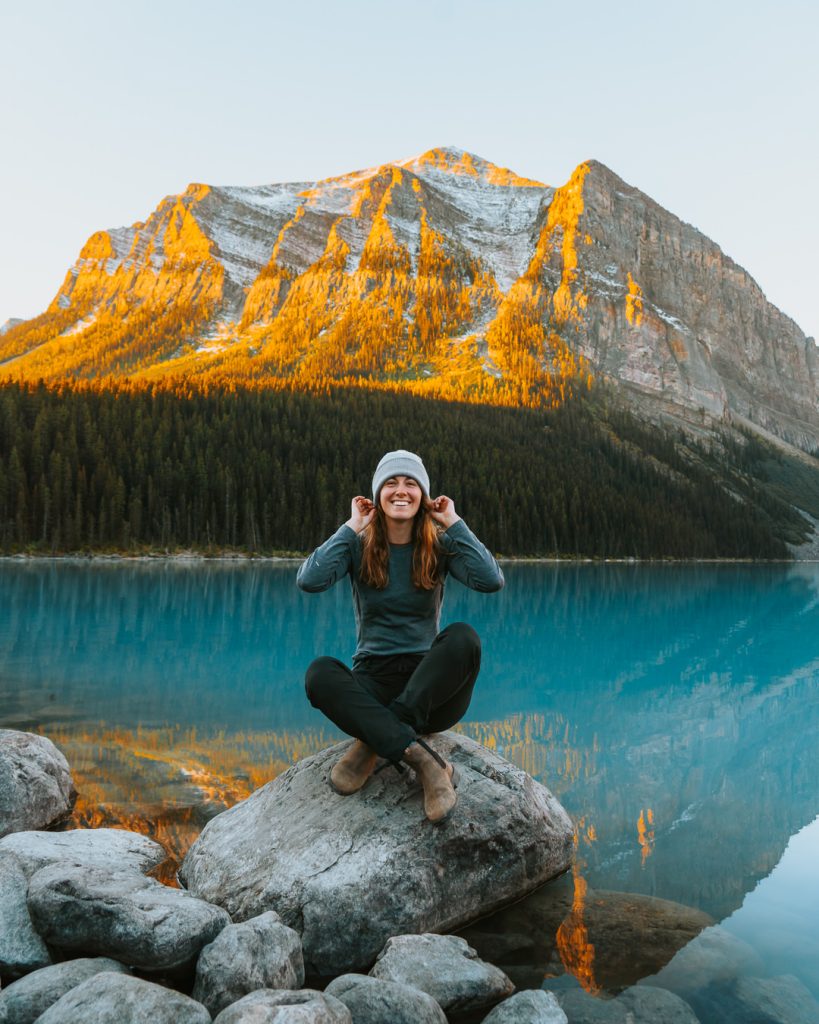
Smartwool Classic All-Season Merino Long-Sleeve
I’ve worn the Smartwool all-season merino under a rain jacket on damp Carolina trails, and also packed it for Alta Via 1 in Italy, where afternoons got too warm for a fleece. It’s the piece I reach for first when layering in the fall. I’ve owned it for over 4 years, and it still looks almost new.
Pros
- Breathable merino wool
- Odor-resistant (wear it more than once)
- Lightweight but warm enough for cooler days
Cons
- Pricier than synthetics (but worth every penny)
- Can be a little big if you’re between sizes, so size down if you want a tight fit
Other Women’s Tops I Like
REI Co-op Midweight Long-Sleeve Base Layer: A dependable budget option I’ve kept for years. I not only love this top for hiking, but it’s also great for running and long walks.
Kari Traa Rose Half-Zip Base Layer: My go-to choice for camping trips when I want something both cute and functional.
Patagonia Retro Pile Marsupial Fleece Pullover – Women’s: A soft fleece that’s perfect when temps dip, but you don’t need a full jacket.
Fall Hiking Tops For Men
Smartwool Classic Thermal Merino Crew Base Layer Top
A great, warm base layer that isn’t too heavy. It’s perfect for those crisp mornings when you need something under a fleece or jacket. The Smartwool Classic Merino Thermal holds up well and doesn’t stretch out like some synthetics do.
Pros
- Warm without being bulky
- Holds its shape after repeated use
- Breathes well even on longer hikes
Cons
- Takes longer to dry if it gets thoroughly soaked
- More expensive than synthetic options (again, worth the money)
More Men’s Tops To Check Out
REI Co-op Midweight Long-Sleeve Base Layer: A budget-friendly pick that’s comfortable and layers easily under a jacket.
Patagonia Lightweight Synchilla Snap-T Fleece Pullover – Men’s: Warm fleece pullover that’s easy to throw on anywhere.
Fall Hiking Jackets For Women
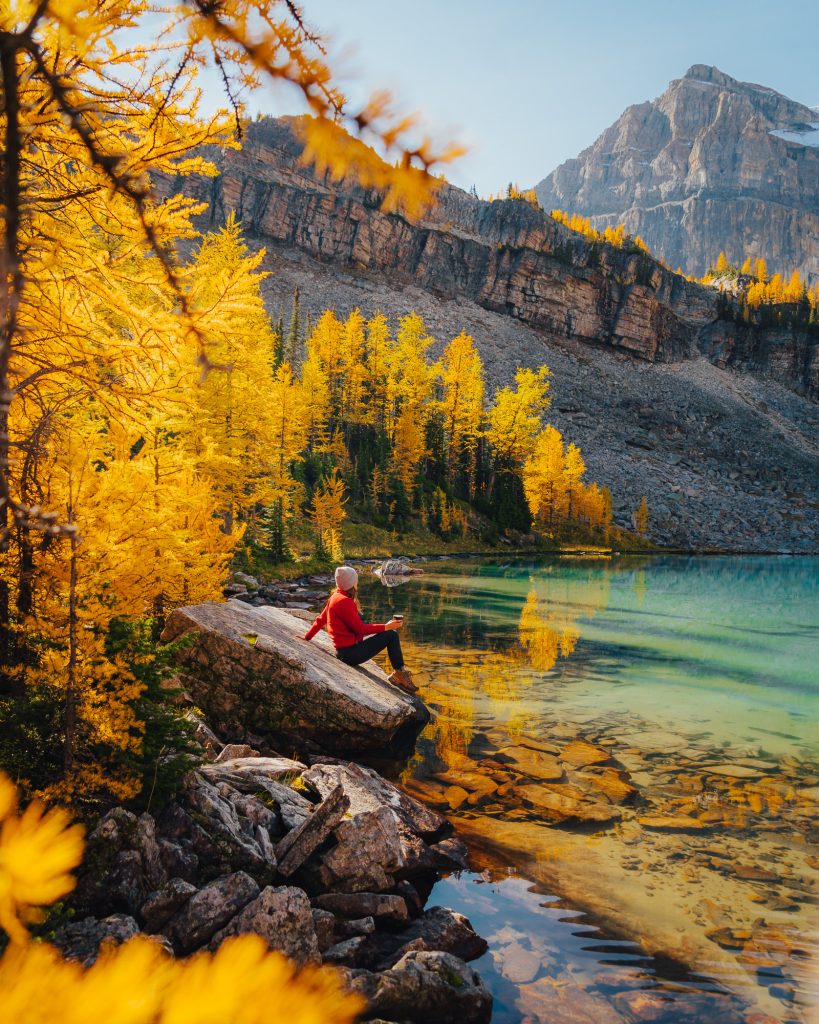
Patagonia Down Sweater
The Patagonia Down Sweater is the jacket I toss in my hiking pack every fall. It’s light to carry but instantly warm when needed. I’ve pulled it out on breezy overlooks plenty of times, and it’s stopped me from shivering through my fair share of late-afternoon hikes.
Pros
- Packs down easily into a backpack
- Reliable warmth for its weight
- Holds up year after year
Cons
- Not built for heavy rain (you’ll still need a shell if it’s going to pour)
More Women’s Jackets I Love
Patagonia Better Sweater Fleece Jacket – Women’s: A fleece that layers well and works just as easily for town days. I often wear this under my Patagonia Down Sweater or by itself if it’s a warmer fall day.
The North Face Yumiori Vest – Women’s: Great for layering when you want to keep your core warm. I often opt for a long-sleeve merino and a vest during mid-day fall hikes, as it’s easy to take off a vest if I get too warm.
REI Co-op 650 Down Vest – Women’s: Affordable insulation that still does the job.
Fall Hiking Jackets For Men
Patagonia R1 Air Full-Zip Hoody
My husband wears this Patagonia Hoodie all the time in the fall. It’s easy to layer, and perfect for hikes that start chilly but warm up by the afternoon. He likes that it never feels restrictive, and it’s simple to zip off and stash in his pack once the sun comes out.
Pros
- Quick-drying material
- Comfortable fit with good mobility
- Stows into backpacks easily
Cons
- Doesn’t block much wind in the face
- Fabric can show wear faster than thicker fleeces
I Also Recommend These
The North Face Terra Peak Insulated Vest – Men’s: Keeps his core warm without overheating on steep climbs.
Patagonia Better Sweater Fleece Vest – Men’s: Layers well over a base when you’re planning a longer hike with uncertain weather.
Outdoor Research Helium Down Hoodie – Men’s: Lightweight down jacket that takes up virtually no room. A must for colder fall trips.
Fall Hiking Bottoms For Women

Coalatree Trailhead Pants (Unisex)
The Trailhead Pants were one of the first pairs of hiking pants I invested in, and they’ve held up exceptionally well. I have them in a couple of different colors, and they go with almost anything.
They don’t scream “hiking pants,” so I wear them for travel too. They dry quickly, clean up easily, and the slim fit feels flattering without excessive fabric getting in the way.
Pros
- Quick-drying and easy to clean
- Adjustable fit at the ankles and waist
- Flattering slim cut
Cons
- No zipper closure, so they can slide a little
- Stiffer feel than softer leggings or joggers
Other Women’s Bottoms I Like
RVRC Norwand Highwaist Stretch Pants: Great for taller women (5’8” and up). Water-repellent with plenty of stretch, but too long on me at 5’6”. I still wear them and roll the bottoms.
Beyond Yoga Leggings: If you prefer a legging to a structured pant, than these are the option for you. I own these in both the legging and biker short version and they are the first pair of leggings to get dirty after laundry day.
Outdoor Voices Rectrek Pants: I didn’t know I’d like zip off pants until I purchased these from Outdoor Voices. They are the PERFECT transition piece, especially for those chilly fall days that turn warm the second it hits the afternoon. I love being able to zip the bottoms off and the shorts are just as cute as the pants.
Fall Hiking Bottoms For Men
Coalatree Trailhead Pants (Unisex)
The Trailhead Pants are unisex, and surprisingly, it was my husband who introduced me to them. I’m typically the one to buy most of his clothing, but his brother, who lives in Colorado and hikes all the time, recommended them years ago.
My husband wears these for almost every single hike and loves to wear them on the plane as well. He’s a man of simple taste who sticks with what he likes, so of course, he has these in numerous colors.
Pros
- Quick-drying and easy to clean
- Adjustable fit at the ankles and waist
- Not bulky at all
Cons
- No zipper closure, so they can slide a little
- Stiffer feel than softer leggings or joggers
More Men’s Bottoms To Try
REI Co-op Sahara Convertible Pants – Men’s: Can be worn as pants or shorts. Easy to add a base layer for cooler days.
Prana Brion Slim Pants II – Men’s: Comfortable slim fit, holds up well for hiking.
Smartwool Classic Thermal Merino Bottoms – Men’s: Wool base layer that’s a step up when temps really start to drop.
Fall Hiking Footwear For Women
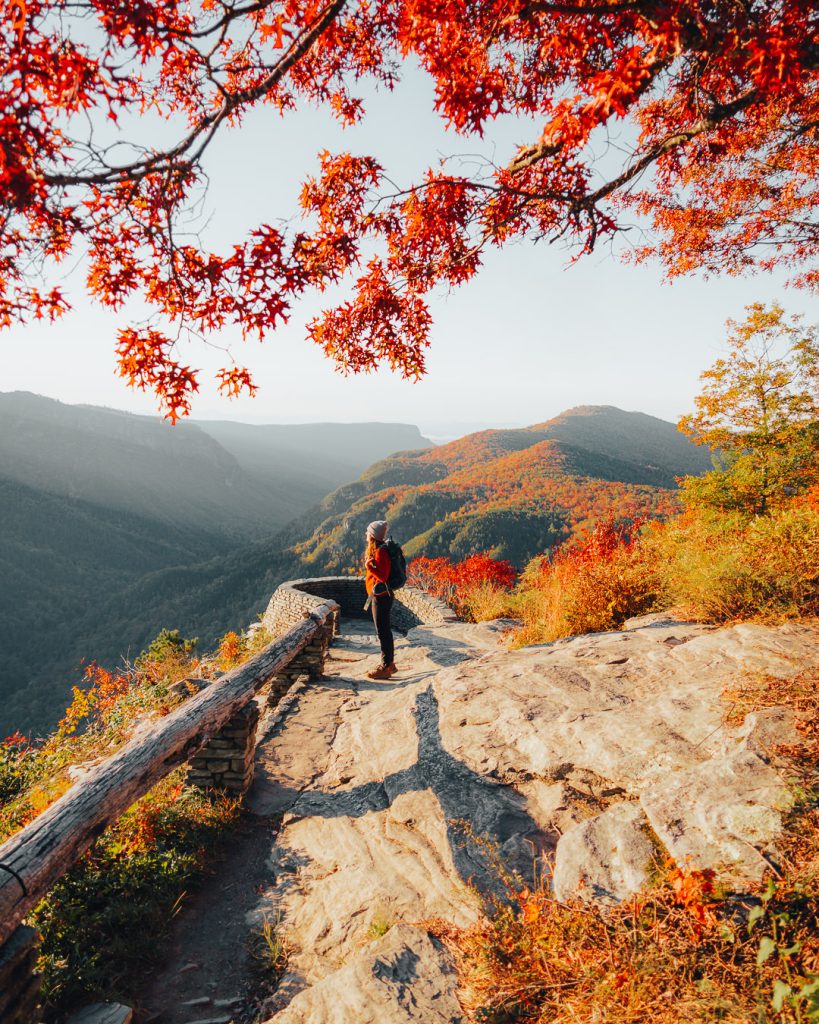
Danner Mountain 600 Leaf GTX Hiking Boots
Fall trails mean slick leaves, thick mud, and the occasional surprise puddle. These boots have handled it all for me without that long, painful break-in period most hikers dread.
They’re waterproof and sturdy, but still light enough that you don’t feel like you’re hauling bricks on your feet.
Pros
- Waterproof yet breathable
- Comfortable right away
- Good traction on damp trails
Cons
- They’re pricier than some, but I’ve never regretted investing in them
- If you have sensitive feet, they don’t do well over 5-6 miles
Other Shoes to Try
Altra Lone PeakTrail Shoes: I transitioned to a wide toe box shoe a few years ago after consistently getting bad blisters and toenails that kept hurting. Typically, I’ll wear these into late fall and then transition to thicker boots for the really cold temps.
Moab 3 Mid Waterproof Hiking Boots: A more affordable option that still holds up great on the trail!
Blundestone Classic Chelsea Boots: I wouldn’t necessarily consider these “hiking boots” but if I’m only planning to do 1-2 miles then I’ll opt for them. They have decent tread and are a great everyday shoe. These take a minute to break in, but once they mold to your feet, they are so comfortable and something you’ll be reaching for all fall.
Darn Tough Light Hiker Micro Crew Socks
Only outdoorsy people keep a running list of their ‘must-have’ socks, but here we are. The truth is, good shoes are only as good as the socks you wear with them.
Darn Tough socks have never let me down. They’ve stayed put on my countless hikes, added cushion where I need it, look great for both men and women, and are something I make sure to take with me on every single trip.
Pros
- Cushion without bulk
- Lifetime durability guarantee
- Fit stays secure on long hikes
Cons
- Higher price than basic socks
- Not so much a con, but they are pretty stiff until softened with a wash
Fall Hiking Footwear For Men
Danner Mountain 600 Leaf GTX Hiking Boots
You might call it “his and hers,” but there’s a reason we match these boots — they perform just as well on both sides.
All the things I like about the women’s version apply here, too. They’re waterproof, grip slick leaves, and break in quickly so you can enjoy your investment sooner with minimal foot punishment.
More Shoe Options
Altra Lone Peak Trail Shoes: A great choice if you prefer a wider toe box and your feet run hot.
Moab 3 Mid Waterproof Hiking Boots: A more cost consciouse choice that’s perfect for those that love a classic hiking boot.
Blundestone Classic Chelsea Boots: Not considered a classic hiking boot, but still has decent tread and is more of an all around shoe if you don’t want to invest in just hiking boots.
Darn Tough Hiker Micro Crew Cushion Socks
There’s nothing worse than socks you notice for the wrong reasons. With these, you forget they’re even on, which is precisely how it should be.
Everything I like about the women’s version applies here too, and they’re just as reliable for men.
Fall Hiking Accessories

If I could pack for you, these are the fall hiking accessories I’d tuck into your bag every single time. They don’t take up much space, but I’ve depended on them enough to know they make hiking outfits for fall a lot more comfortable.
The North Face Etip Recycled Gloves – Women’s / Sierra Etip Gloves – Men’s
These gloves have saved me from frozen fingers on plenty of cold trailheads. They’re warm but not bulky, and the touchscreen tips actually work. I can check the map or take photos without having to peel them off every five minutes, which is super important to me.
The men’s version has just as many great reviews as the woman’s which gives me confidence that they’re just as great.
Black Diamond Midweight Screentap Fleece Gloves
This is another pair of gloves I always have with me. They also work well for cooler hikes when I don’t need full-on winter gear yet.
Herschel Supply Co. Elmer Beanie
I live in this beanie once the weather turns — it’s comfortable, simple, and goes with just about anything I throw on. I’ve worn it on hikes, in camp, and even to grab dinner after a long day outside.
Smartwool Thermal Merino Reversible Cuffed Beanie
Merino is always my first choice for warmth, and this beanie has been perfect for hikes where I need insulation that still breathes. It keeps the chill out without leaving me feeling sweaty.
Rechargeable Hand Warmers
These little guys are a lifesaver when the weather takes a turn. I slip them in my jacket pockets and keep moving, and it’s incredible how much difference warm hands make when the rest of you is tired and chilled.
Rechargeable Headlamp
With shorter daylight hours in the fall, I never leave home without this. It’s the difference between walking confidently back to the trailhead and fumbling around in the dark trying to find the car.
Just make sure your headlamp is charged before hitting the trails. Nothing is worse than the sun setting and realizing your only light source is dead.
Nomadix Ultralight Towel
This towel lives in my pack year-round. You never know when the weather will turn or when you’ll end up covered in mud.
Top tip: it’s also a game-changer when hiking with dogs.
Fall Hiking Outfits For Women

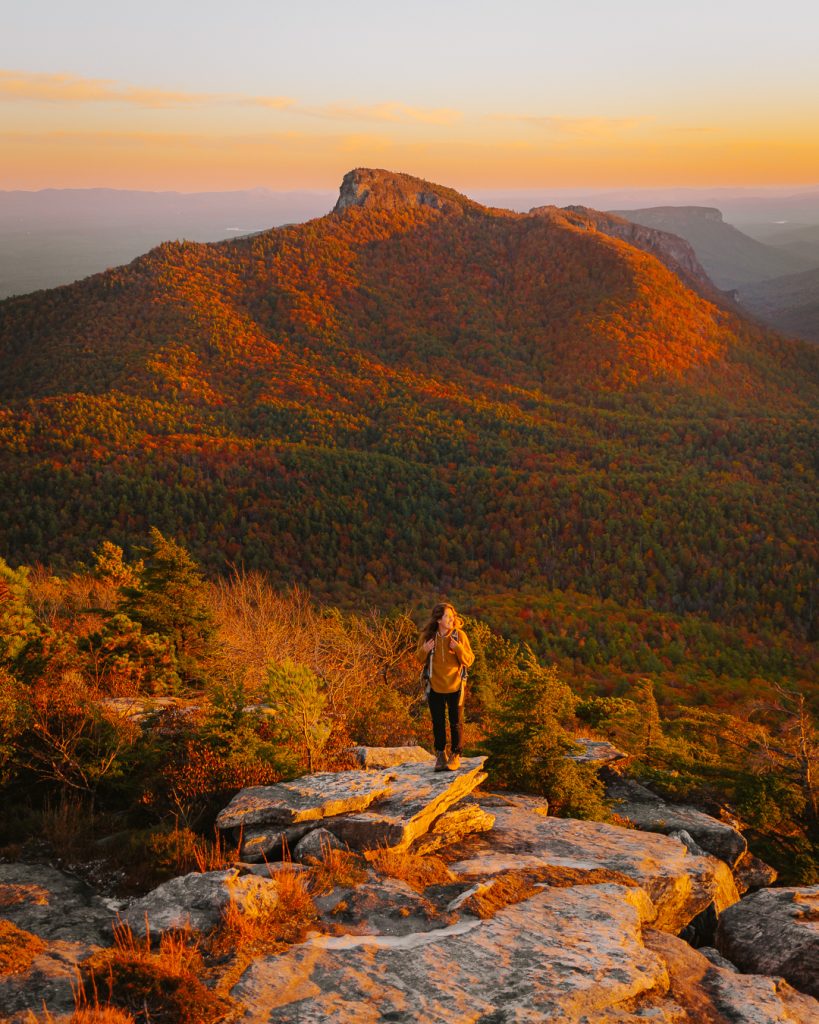
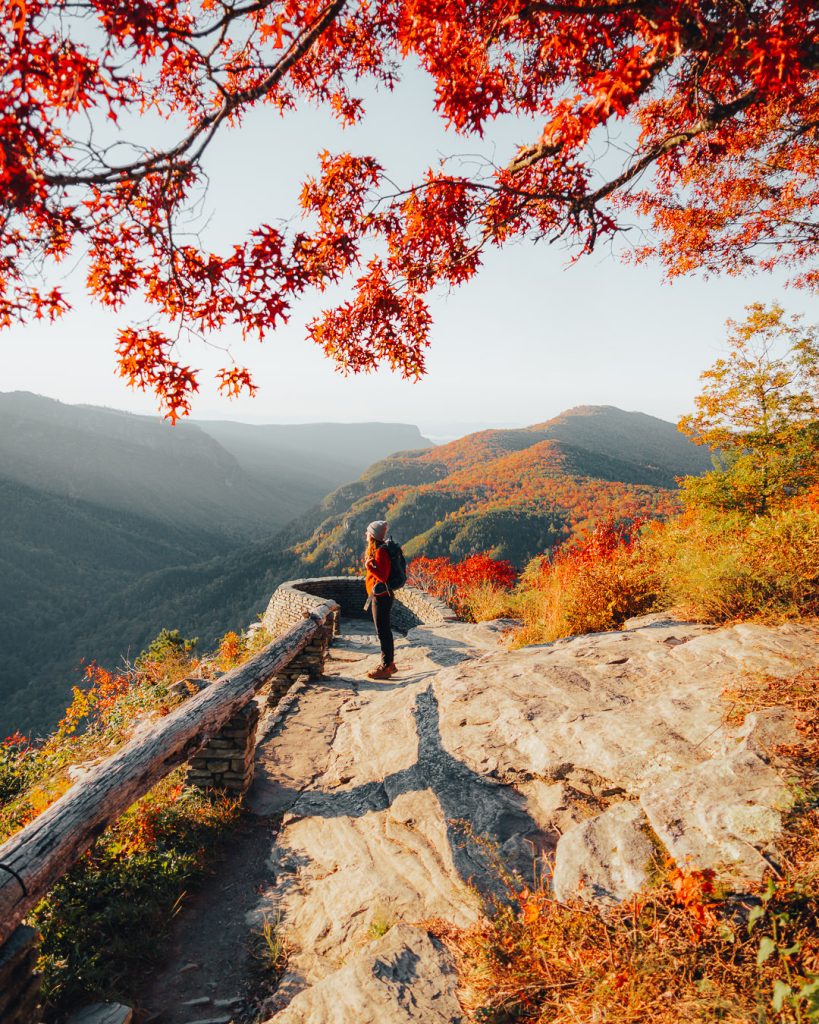

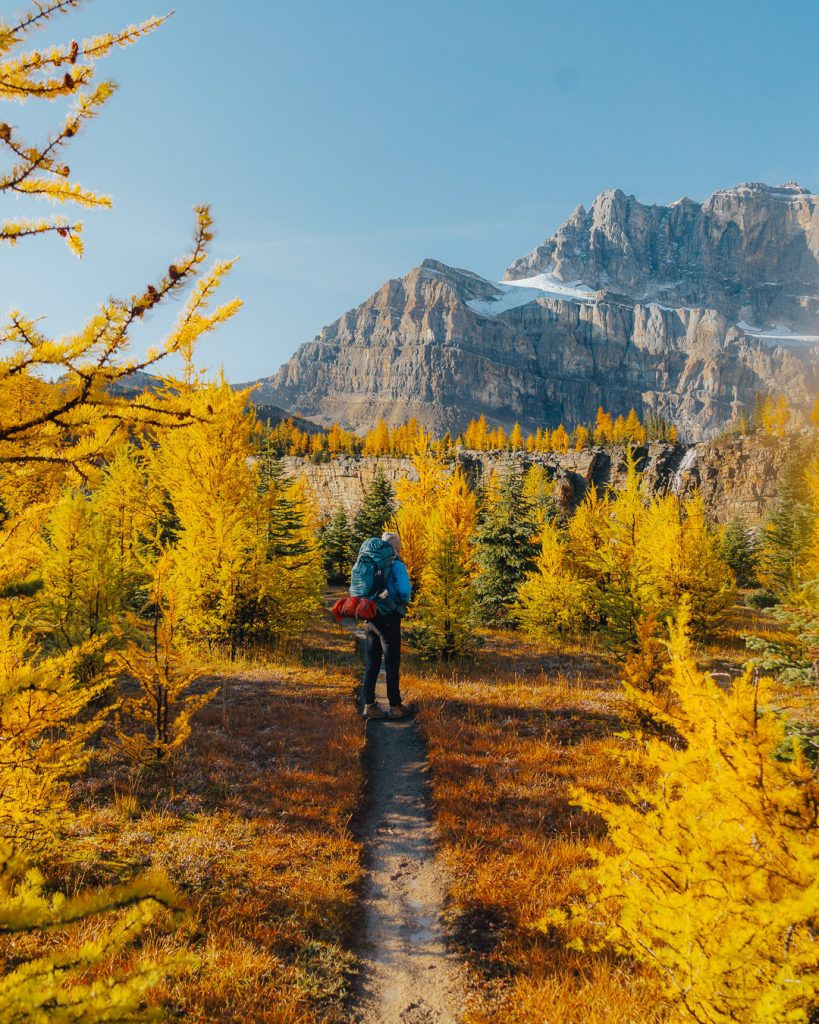
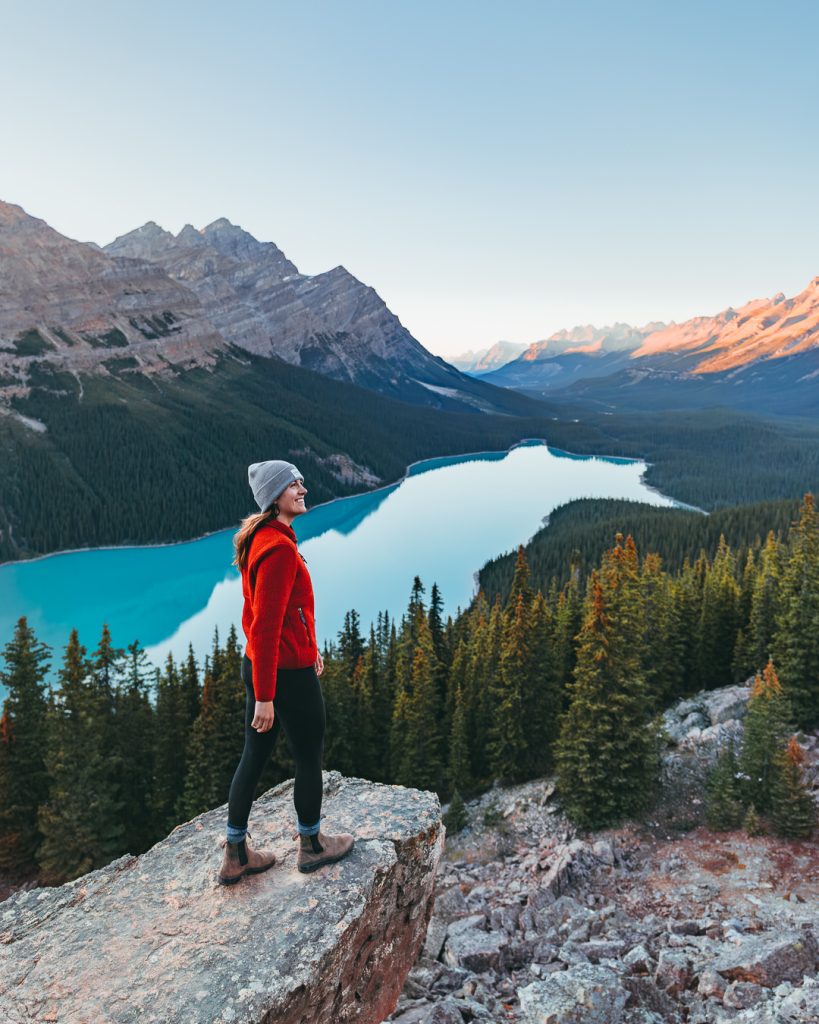

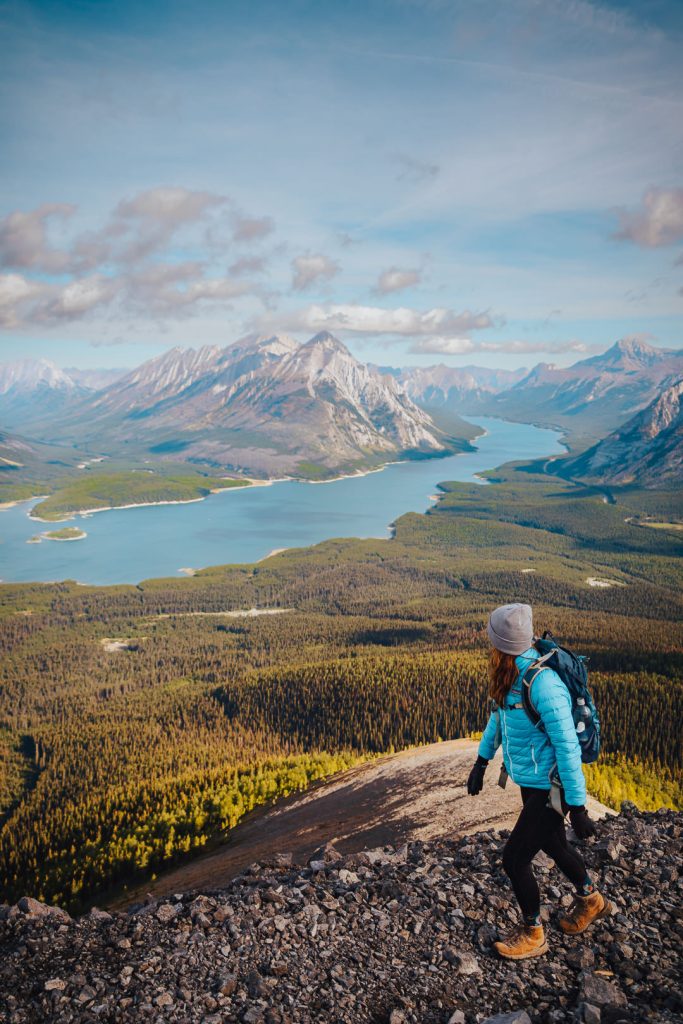
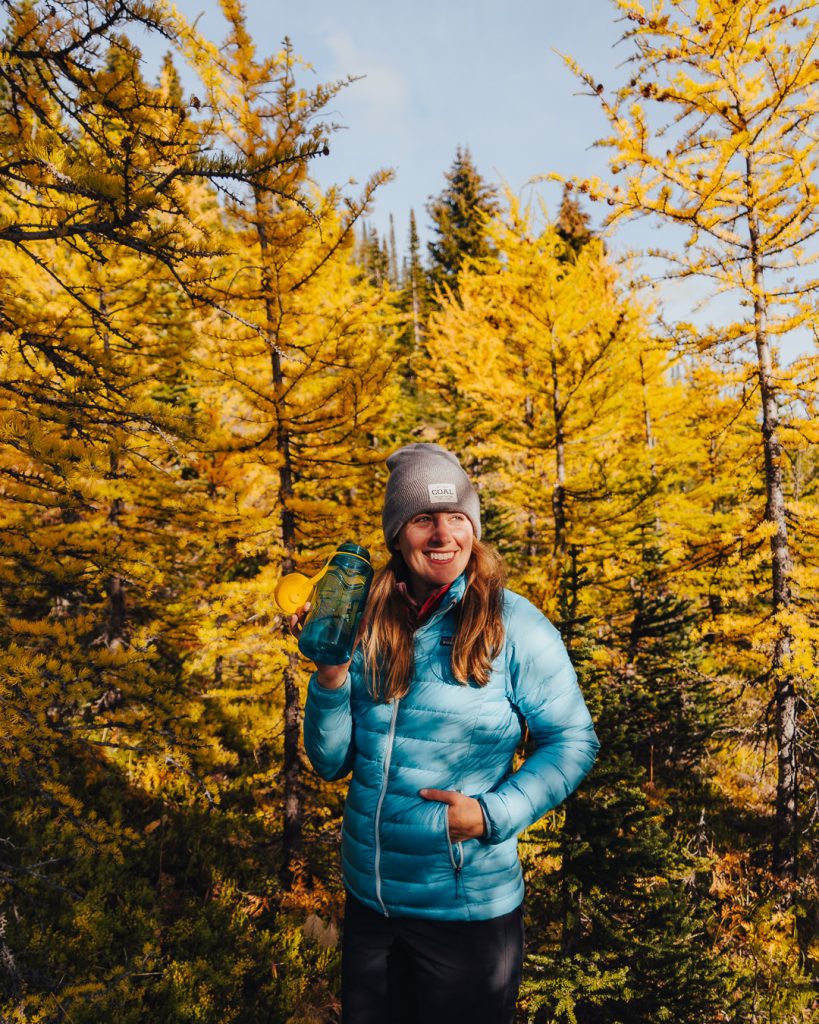
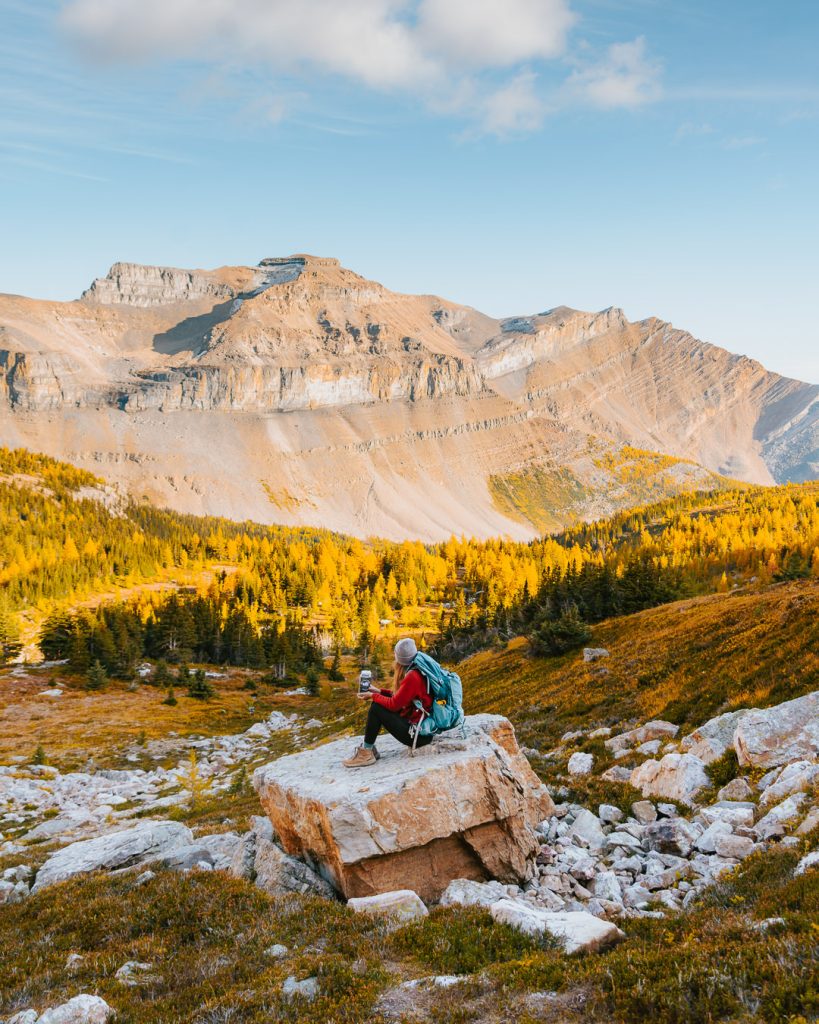
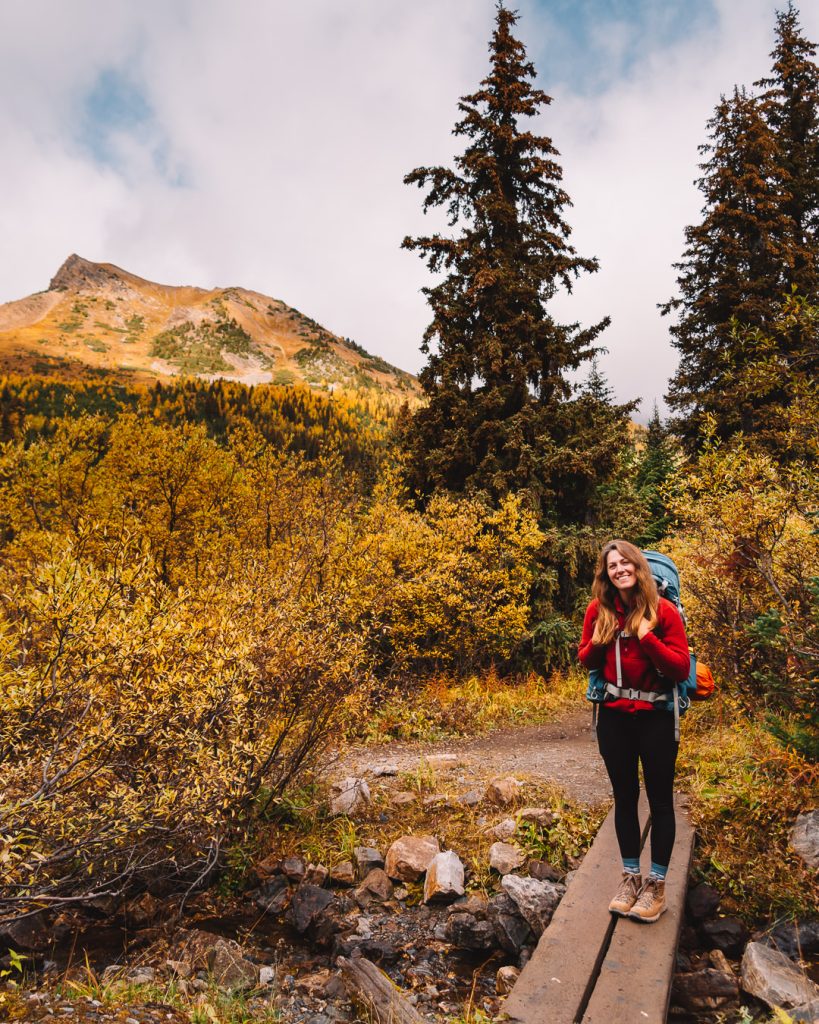
Here are some of my favorite go-to combinations:
Danner Mountain 600 Boots, Darn Tough Socks, Beyond Yoga Leggings, Smartwool Merino Long-Sleeve, Patagonia Retro Pile, Herschel Beanie
Danner Mountain 600 Boots, Darn Tough Socks, Coalatree Trailhead Pants, Smartwool Merino Long-Sleeve, Patagonia Down Sweater
Danner Mountain 600 Boots, Darn Tough Socks, Beyond Yoga Leggings, REI Long-Sleeve, 650 Down Vest
For ladies who love a trendy option, Free People has some amazing hiking option like the Retro Rider Layer, the Pippa Packable Pullover, and the Set Me Free Pants!
Fall Hiking Outfits For Men
My husband pretty much wears the exact same outfit every time we go hiking in the fall. When it comes to fashion, he’s a simple man.
Here’s his line up: Coalatree Pants, Smartwool Long-Sleeve or Short-Sleeve (depending on the daily high-temp), Patagonia Fleece, and Patagonia Jacket.
Hiking Outfits For Fall: Layering Tips
Fall weather can’t always make up its mind, which is why layering matters. The right mix means you can peel things off or add them back on without feeling miserable halfway through your hike.
Base-Layer
This sits right against your skin and sets the tone for how comfortable you’ll be. I stick to merino wool or synthetics that wick sweat.
I learned the hard way early on that cotton is a no-go; once it gets wet, it stays damp, and that means you’ll stay cold.
Mid-Layer
Think fleece or a lightweight hoodie, something that traps warmth but still breathes. This is usually the layer I end up taking on and off the most.
If it’s a cool morning, it goes on right away. Once the sun comes out or the climb kicks in, it’s the first thing I pull off and stuff in my pack or tie around my waist.
Insulating Jacket
This is the extra layer I might not wear right away, but always bring.
A down or synthetic puffy doesn’t add much weight to my pack and makes a big difference when the air turns colder, or the wind picks up.
Hiking in Fall Safety Tips
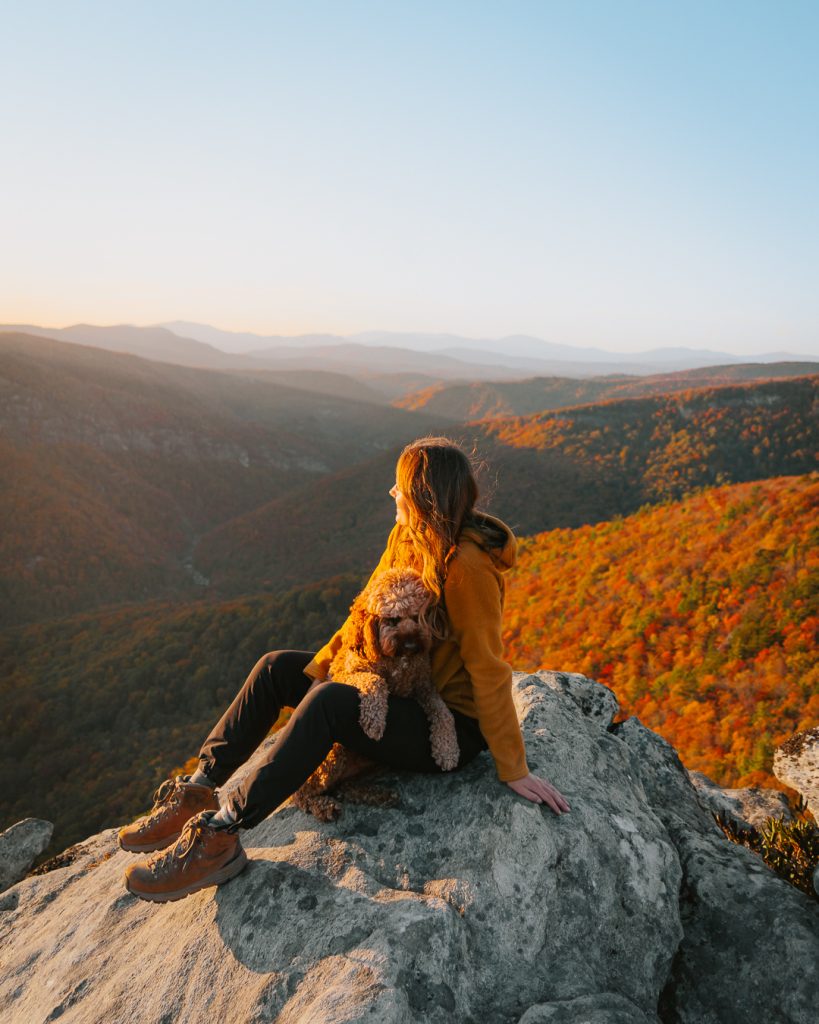
Fall hiking is gorgeous, but it comes with its own set of challenges. These are a few habits I keep in mind every time I’m on the trail:
- Start early & plan your turnaround time. The light fades faster in fall, so I pick trails I can finish before dark or know where I’ll turn back if I need to.
- Keep an eye on the forecast. A blue-sky morning can flip to rain or even snow at higher elevations. Extra layers are always in my pack.
- Watch your footing. Wet leaves and mud hide roots and rocks, and it’s easy to lose traction if you’re not paying attention.
- Remember, animals are busy too. Fall is when wildlife starts gearing up for winter. Squirrels are stashing food, deer get more active, and you might bump into other critters earlier or later in the day. I try to give them space and never leave food out — nobody wants a trail that teaches animals to expect snacks from hikers.
Bring enough water and fuel. Cool weather makes it easy to forget, but you’ll still need steady hydration and snacks to keep warm and energized.
Finding The Best Hikes
As an outdoor photographer, I’ll never pass up the chance to plan hikes around peak fall colors. That’s why I lean on foliage maps every year.
These are basically guides that predict when and where leaves will change color. They’re usually updated weekly in the fall and use past patterns, current temps, and rainfall to estimate peak color.
They’re not perfect, but they’re super helpful for planning. If a map shows “high color” in a particular area for mid-October, that’s your window to head out there with your hiking boots and camera. If it shows “past peak,” expect more bare branches than color.
It’s super easy to find a foliage map for your destination. Just Google “destination + foliage map” and the latest version should come right up. I also recommend looking at drought patterns to understand how vibrant the colors will be. If it’s been a dryer year, expect duller colors in general.
I might be biased, but the Carolinas are one of the most beautiful places I’ve seen during the fall. Places like Highlands, Brevard, and the Asheville trails are some of my favorite spots to check when I know the colors are peaking.
If you want waterfall views mixed in with fall foliage, these North Carolina’s waterfall hikes are some of my favorites.
I’ve also explored the Canadian Rockies during the fall (the larches are spectacular), Minnesota, and Arizona. Wherever you’re visiting, ensure you understand when color changes for that area (very different for Canada vs. South Carolina) so you aren’t surprised by green leaves or bare trees.
FAQs: Hiking Outfits For Fall
Is it better to hike in jeans or leggings?
Jeans are heavy, hold moisture, and don’t stretch well, which makes them uncomfortable on the trail. Leggings or hiking pants are a much better choice since they wick sweat and move with you.
If it’s chilly, I’ll sometimes wear leggings under hiking pants for extra warmth. I’ve shared some of the best here in my Ladies Hiking Pants guide.
What to wear for a 70-degree hike?
Seventy degrees sounds warm, but shade and wind can make it feel different. I’d usually wear a lightweight top, breathable pants or shorts, and keep a fleece in my pack in case it cools off.
Merino or synthetic fabrics are the way to go, since they dry quickly and keep you comfortable when you start sweating. For shorts, you can check out my go-to Hiking Shorts for Women list.
What to wear on a rainy hike?
A rain jacket is a must. I’ll pair it with a quick-dry base layer, hiking pants, and wool socks to keep my feet warmer even if they get wet.
Waterproof boots make puddles less of a headache. I also bring a small towel like the Nomadix Ultralight so I can dry off before heading home.
What to wear hiking in the summer?
In summer, I keep it light. A moisture-wicking tee, shorts or thin pants, and breathable boots or trail runners work well. I always wear a hat for sun protection and pack more water than I think I’ll need.
Quick-drying clothes are key because once you’re hot and sweaty, you’ll want fabrics that don’t cling or stay damp.
Wrap-Up: Hiking Outfits For Fall
I know this post might feel a little daunting, but the prep is so worth it. The right layers make your hike easier and more enjoyable, and most of these pieces will last you for many seasons to come.
Once you’re out there with the leaves changing, you’ll be glad you packed smart, I always am!
